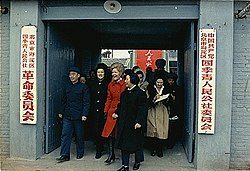| ||
|---|---|---|
Personal U.S. Representative from California U.S. Senator from California 36th Vice President of the United States
Post-vice presidency 37th President of the United States
Appointments Policies Tenure
Post-presidency Presidential campaigns Vice presidential campaigns
 | ||
From February 21 to 28, 1972, President of the United States Richard Nixon visited Beijing, capital of the People's Republic of China (PRC) in the culmination of his administration's efforts to establish relations with the PRC after years of U.S. diplomatic policy that favored the Republic of China in Taiwan. [1] His visit was the first time a U.S. president had visited the PRC, with his arrival ending 23 years of no official diplomatic ties between the two countries. Nixon visited the PRC to gain more leverage over relations with the Soviet Union, following the Sino-Soviet split. The normalization of ties culminated in 1979, when the U.S. transferred diplomatic recognition from Taipei to Beijing and established full relations with the PRC.
Contents
- Visit
- Historical background
- Readiness
- Travel to China
- Meeting with Mao
- Other activities
- Results
- See also
- References
- Further reading
- External links
When the Chinese Communist Party gained power over mainland China in 1949 and the Kuomintang retreated to the island of Taiwan (a former Qing prefecture turned Japanese colony that was acquired following the Surrender of Japan in 1945) after the de facto end of the Chinese Civil War, the United States continued to recognize the Republic of China (ROC) as the sole government of China, now based out of Taipei. Before his election as president in 1968, former vice president Richard Nixon hinted at establishing a new relationship with the PRC. Early in his first term, Nixon, through his National Security Adviser Henry Kissinger, sent subtle overtures hinting at warmer relations to the government of the PRC. After a series of these overtures by both countries, Kissinger flew on secret diplomatic missions to Beijing in 1971, where he met with Chinese premier Zhou Enlai. On July 15, 1971, the President announced on live television that he would visit the PRC the following year. [2]
The visit allowed the American public to view images of mainland China for the first time in over two decades. Throughout the week the President and his senior advisers engaged in substantive discussions with the PRC leadership, including a meeting with CCP chairman Mao Zedong, while First Lady Pat Nixon toured schools, factories and hospitals in the cities of Beijing, Hangzhou and Shanghai with the large American press corps in tow. Nixon dubbed his visit "the week that changed the world", a descriptor that continues to echo in the political lexicon. Repercussions of the Nixon visit continue to this day; near-immediate results included a significant shift in the Cold War balance, driving an ideological wedge between the Soviet Union and the People's Republic of China, resulting in significant Soviet concessions and its eventual fall.
The consequences of Nixon's trip to China continue to impact politics today. Writing on the 40th anniversary of the trip, Jeffrey Bader said that the basic bargain to put common interests ahead of ideology and values which both Nixon and Mao sought had been substantially held by both the Democratic and Republican parties. [3] Also, a "Nixon to China" moment has since become a metaphor to refer to the ability of a politician with an unassailable reputation among their supporters for representing and defending their values to take actions that would draw their criticism and even opposition if taken by someone without those credentials. [3]








